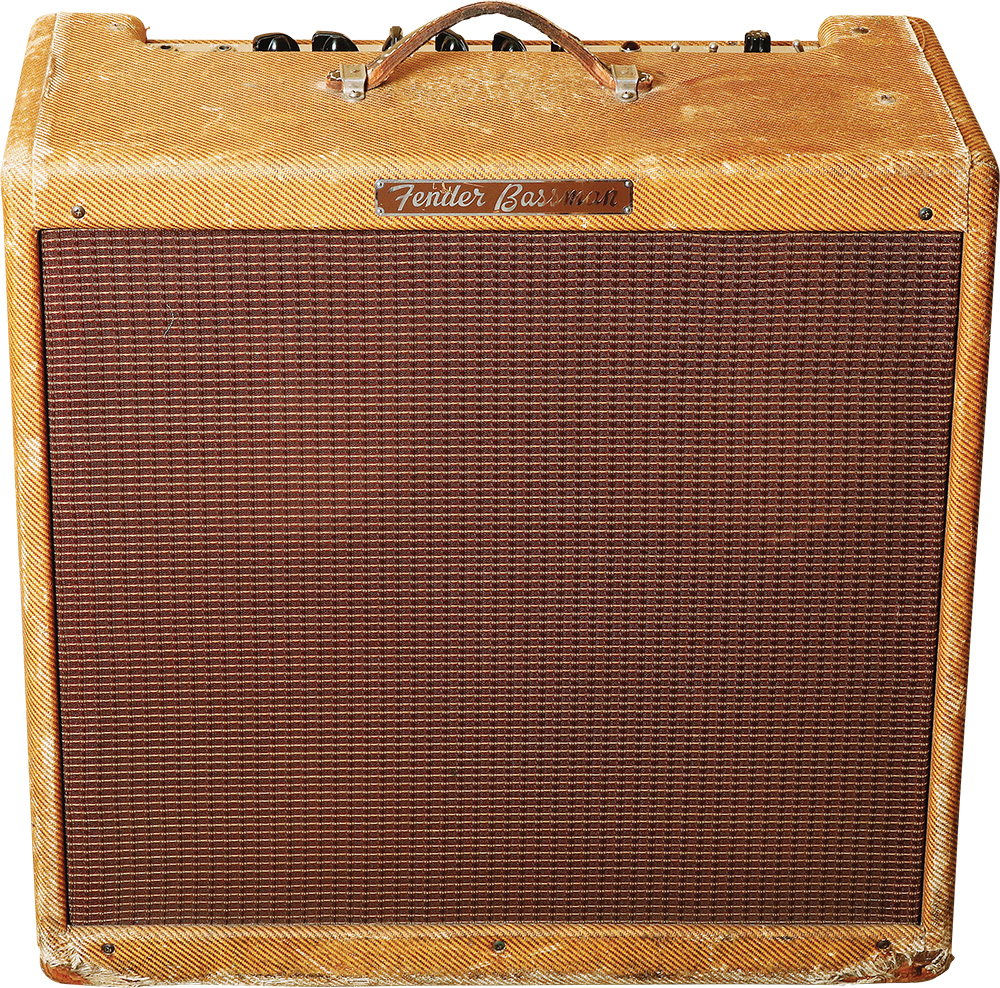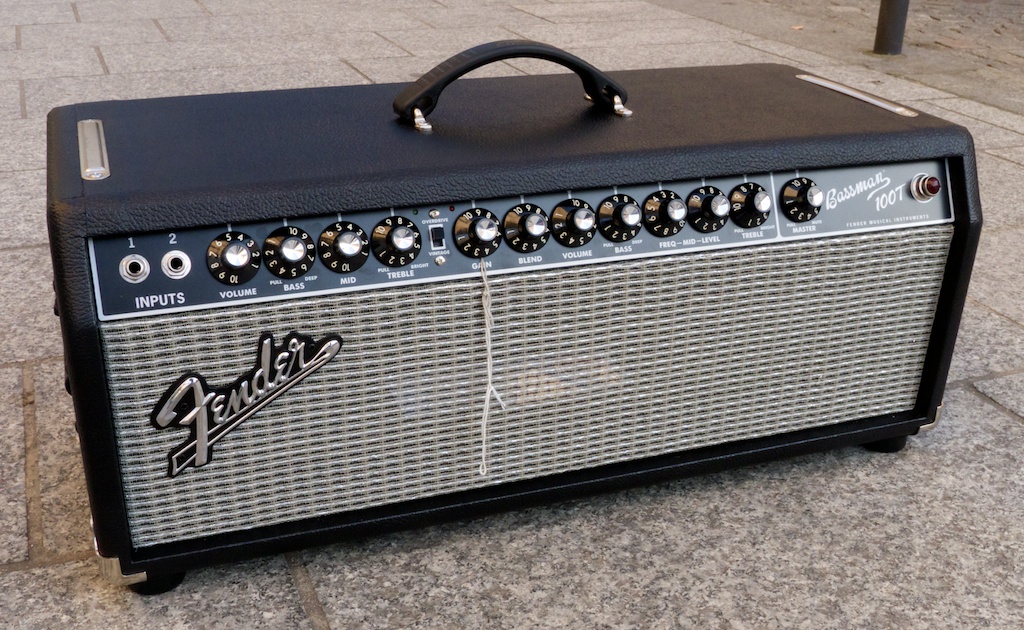Fender Bassman
48 results for 'fender bassman' Amazon's Choice for fender bassman. Fender '59 Bassman LTD 50-Watt 4x10-Inch Tube Bass Combo Amp. 4.3 out of 5 stars 14. Fender Bassman 100 Combo (Discontinued) The Fender Bassman 100 Combo Amp features a tilt-back real wood cab. 100W and single 10' driver with horn, 3-band EQ with semi-parametric mid, contour, and XLR output for recording or PA reinforcement with level, pre/post switch, and ground lift. RCA aux in for CD player, effects loop, and more. The Flagship Fender Bass Amp The flagship of the Fender bass amp lineup is the mighty Super Bassman. One of the most powerful and versatile Fender bass amps ever made, it's a stadium-level 300-watt tube head designed for the biggest shows and the largest stages, with enormous Fender bass sound and sparkling vintage-style Fender looks.

The Fender Bassman emerged from the factory to give voice to the bass. But it went on to become a classic for guitarists as well, spawning many tributes along the way.
Sometimes, it’s all in a name. The Bassman was introduced by Fender in 1952 to give voice to their brand new toy, the solid-bodied Precision bass. A single 15-inch driver was placed into a TV-fronted cabinet (so-called because it looked like the televisions of the time) and the new invention of the bass guitar could suddenly be heard on stage and in the studio.
This was just the beginning of the Fender Bassman adventure though. The 15-inch driver configuration for a bass amplifier was perfected by Ampeg a decade after the Bassman’s arrival, but Fender’s invention would go onto have a life beyond the four-stringed guitar, becoming one of the most recognised pieces of kit to adorn backlines all over the world.
The golden age
With the development of the first solid-body electric bass, Fender was charged with somehow giving this instrument a chance to be heard in all its glory. This brought about the release of the first Fender Bassman model, the 5B6. From 1952 to 1954 there was little change in the design, which featured two 6SC7 preamp tubes, two 5881 power tubes, a 5U4G rectifier and capable of pumping out 26 watts of power.
Fender Bassman 50
The first major upgrade came with 5D6 Bassman. The single driver was switched out in favour of a four-by-ten configuration, on account of complaints that the single driver wasn’t capable of handling low frequencies without distortion. And despite the fact that the amp was originally marketed as a bass-only beast, it featured Normal and Bright inputs: the Bassman’s reputation for being a superb guitar amp was catching on and Fender was listening.

In ’55 more controls were added – Treble, Bass and Presence – to make this model appeal even more to the burgeoning market of electric guitarists. Other minor reiterations of the amp were released throughout the ’50s until the line reached its zenith with the 5F6-A. Rather than being a complete redesign, the 5F6-A (released in 1958) marked a culmination of all the minor adjustments throughout the amp’s history. In Vintage Guitar, Dave Hunter points out a couple of the specs that added to this particular model’s mojo:
“Among these [upgrades] was the removal of the 1.5k-ohm resistors between the coupling caps and the grids that served as the inputs to the dual 5881 output tubes (a high-grade variant of the 6L6GC), a change that helped make the amps a hair livelier.”
In fact, it was this model that was to play a pivotal role in the development of an eventually iconic amp maker from across the pond. When Jim Marshall hired Ken Bran, Dudley Craven and Ken Underwood to design the first amp under the Marshall name, they appropriated the design of the 5F6-A in their legendary JTM 45.

At the time, it didn’t hurt to be endorsed by Buddy Holly. Blues slingers like Stevie Ray Vaughanand Buddy Guywould also fall under the spell of this dynamic and characterful version of the Fender Bassman. When people think of the Fender ‘Tweed’ sound, the 5F6-A is at the centre of their tonal fantasies.
A time of change
As if they knew that they couldn’t improve upon the 5F6-A, Fender decided to take the Bassman in a different direction. The ‘piggy-back design of the early ’60s became an icon in its own right, with the 6G6 splitting the head and cabinet. The ‘blackface’ era of Fender amps brought about a two-by-twelve design, as well as a smaller-sized but impactful amp series, the Deluxe Reverb.
Fender faced a period of considerable tumult in 1965 when they were bought out by CBS. The quality of their guitars took an infamous nose-dive in subsequent years and for a period, the Bassman appeared to have lost its way too. A short sojourn in solid-state amps produced a massive 105-watt model, complete with three 12-inch speakers.
And while Ampeg had definitely eaten into Fender’s market share by the late ’60s, they hadn’t let go of the dream of creating the ultimate bass amp. In 1969, the Super Bassman model was introduced, the most expensive amp that Fender had produced, delivering a bone-crushing 100 watts of all-valve power.
Fender Bassman 65
Through all these iterations up until the late ’60s and beyond, it’s the ‘Tweed’ era that has earned the most tributes. Fender itself has reissued the ’59 Bassman, based on the BF6-A on two separate occasions and Jim Marshall had no qualms with starting his own empire from this blueprint. BOSS and Sansamp have also launched pedals that cop the immortal tone of this period.
The Fender Bassman was dreamt up to amplify the new invention of the bass. Though it did this job well enough, it became a true legend in the hands of guitarists.